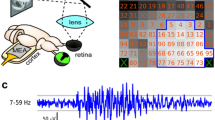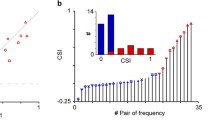Summary
In the toad, Bufo americanus, single units of the caudal thalamus were sensitive to either moving or stationary visual objects. Furthermore, some units responded to tactile as well as visual stimulation. On the basis of analysis of the response characteristics of more than 300 single units, the following provisional classification is proposed:
-
1.
Spontaneously active units which did not seem to have sensory inputs.
-
2.
Units which responded only to tactile stimulation (usually bilateral). The ipsilateral input was typically weaker than the input from the contralateral skin.
-
3.
Units with relatively small excitatory receptive visual fields (ERF: 15°–30°) that were best activated by moving black objects of 10° or more in size. To diffuse light changes they showed “off”-responses.
-
4.
Large-field units whose excitatory receptive fields (ERF) included the entire contralateral visual field, or the whole visual field, as seen via both eyes. Most of these units were typically responsive to each new kind of object motion, but they quickly adaptated to a repeated movement within a particular region of the field.
-
5.
Units that seemed to be variants of types 3 and 4 had ERF's that could change their size, according to circumstances that are not yet known: (a) “Small field” units that could double their size along either the horizontal or vertical axis, (b) Large field units that had a distinct “blind area” centered about the rostral midline; the width of this blind spot could narrow down from the usual 60° distance to only 20–10°. (c) Large field units that were continuously sensitive to the ipsilateral eye, but following tactile stimulation of the contralateral side would respond to contralateral visual movement as well.
-
6.
Units that were maximally stimulated by dark objects moved in the “z-axis”. Although the ERF usually included the entire visual field, movements toward the eye from the dorsal direction were most effective.
-
7.
Darkness-sensitive units included (a) those with a tonic discharge following the dimming of room lights, and (b) others that gave tonic discharge to light-on and were inhibited during darkness.
-
8.
Spontaneously active units with either excitatory (ERF) or inhibitory receptive fields (IRF) that seemed to include the entire visual field. Any moving object within the IRF caused an immediate inhibition, followed by a gradual return of activity to the background level. Some of these units also had a smaller ERF within a large IRF.
-
9.
Units activated by moving objects that continued to discharge for 10 seconds or more after the object had disappeared (“memory-units”).
-
10.
Units with some of the above characteristics that had the additional property of giving a prolonged response to stationary objects. The ERF-sizes varied from 30° to 90°.
Similar content being viewed by others
References
Abplanalp, P.: Some subcortical connections of the visual system in tree shrews and squirrels. Brain, Behav. and Evol 1–4.-Conference on “Subcortical visual systems”. M. I. T. Cambridge, Mass.: Basel: S. Karger 1970.
Branston, N. M., Fleming, D. G.: Efferent fibers in the frog optic nerve. Exp. Neurol. 20, 611–623 (1968).
Ewert, J.-P.: Elektrische Reizung des retinalen Projektionsfeldes im Mittelhirn der Erdkröte (Bufo bufo L.). Pflügers Arch. ges. Physiol. 295, 90–98 (1967a).
—: Aktivierung der Verhaltensfolge beim Beutefang der Erdkröte durch elektrische Mittelhirnreizung. Z. vergl. Physiol. 54, 455–481 (1967b).
—: Der Einfluß von Zwischenhirndefekten auf die Visuomotorik im Beutefangund Fluchtverhalten der Erdkröte (Bufo bufo L.). Z. vergl. Physiol. 61, 41–70 (1968).
—: Das Beutefangverhalten Zwischenhirn-defekter Erdkröten (Bufo bufo L.) gegenüber bewegten und ruhenden visuellen Mustern. Pflügers Arch. 306, 210–218 (1969a).
—: Quantitative Analyse von Reiz-Reaktionsbeziehungen bei visuellem Auslösen der Beutefang-Wendereaktion der Erdkröte (Bufo bufo L.). Pflügers Arch. 308, 225–243 (1969b).
—: Neural mechanisms of prey-catching and avoidance behavior in the toad (Bufo bufo L.) Brain Behav. and Evol 1–4.-Conference on “Subcortical visual systems”. M.I.T. Cambridge, Mass. Basel: S. Karger 1970.
- Aufnahme und Verarbeitung visueller Informationen im Beutefang- und Fluchtverhalten der Erdkröte (Bufo bufo L.). Verh. Dtsch. Zool. Ges. Köln, 218–226 (1970).
- Borchers, H.-W.: Reaktionscharakteristik von Neuronen aus dem Tectum opticum und Subtectum der Erdkröte (Bufo bufo L.). Z. vergl. Physiol. in press (1971).
—, Rehn, B.: Quantitative Analyse der Reiz-Reaktionsbeziehungen bei visuellem Auslösen des Fluchtverhaltens der Wechselkröte (Bufo viridis Laur.). Behaviour 35, 212–234 (1969).
—, Speckhardt, I., Amelang, W.: Visuelle Inhibition und Exzitation im Beutefangverhalten der Erdkröte (Bufo bufo L.). Z. vergl. Physiol. 68, 84–110 (1970).
Gaze, R. M.: The representation of the retina on the optic lobe of the frog. Quart. J. exp. Physiol. 43, 475–486 (1968).
—, Keating, M. J.: Receptive field properties of single units from the visual projection to the ipsilateral tectum in the frog. Quart. J. exp. Physiol. 55, 143–152 (1970).
Grüsser, O. J., Grüsser-Cornehls, U.: Die Informationsverarbeitung im visuellen System des Frosches. In: Kybernetik, p. 331–360. München: Oldenbourg 1968.
—, Finkelstein, D., Henn, V., Patutschnik, M., Butenandt, E.: A quantitative analysis of movement detecting neurons in the frog's retina. Pflügers Arch. ges. Physiol. 292, 100–106 (1967).
Horn, G., Hill, M.: Responsiveness to sensory stimulation of units in the superior colliculus and adjacent tectotegmental regions of the rabbit. Exp. Neurol. 14, 199–223 (1966).
—: Modifications of receptive fields of cells in the visual cortex occuring spontaneously and associated with bodyly tilt. Nature (Lond.) 221, 186–188 (1969).
Ingle, D.: Visual releasers of prey-catching behavior in frogs and toads. Brain, Behav. Evol. 1, 500–518 (1968).
—: Visuomotor functions of the frog's optic tectum. Brain, Behav. and Evol 1–4.— Conference on “Subcortical Visual Systems”. M. I. T. Cambridge, Mass.: Basel: S. Karger 1970.
- Prey-catching behavior of anurans toward moving and stationary objects Vision Res., in press (1971).
Keating, M. J., Gaze, R. M.: Observations on the “surround” properties of the receptive fields of frog retinal ganglion cells. Quant. J. exp. Physiol. 55, 129–142 (1970).
Lázár, G.: Efferent pathways of the optic tectum in the frog. Acta biol. Acad. Sci. hung. 20, 171–183 (1969).
—, Székeley, Gy.: Golgi studies on the optic center of the frog. J. Hirnforsch. 9, 329–344 (1967).
Lettvin, J. Y., Maturana, H. R., McCulloch, W. S., Pitts, W. H.: What the frog's eye tells the frog's brain. Proc. Inst. Radio. Eng. 47, 1940–1945 (1959).
—, Maturana, H. R., Pitts, W. H., McCulloch, W. S.: Two remarks on the visual system of the frog. In: Sensory communication, ed. W. A. Rosenblith, pp. 757 to 776. Cambridge, Mass.: M. I. T. Press 1961.
Maturana, H. R., Lettvin, J. Y., McCulloch, W. S., Pitts, W. H.: Anatomy and physiology of vision in the frog (Rana pipiens). J. gen. Physiol. 43, Suppl. 129–175 (1960).
Muntz, W. R. A.: Microelectrode recordings from the diencephalon of the frog (Rana pipiens) and a blue-sensitive system. J. Neurophysiol. 25, 699–711 (1962).
Pickering, S. G., Varju, D.: Delayed response of ganglion cells in the frog retina: The influence of stimulus parameters upon the length of the delay time. Vision Res. 9, 865–879 (1969).
Rezvin, A. M.: Some characteristics of wide-field units in the brain of the pigeon. Brain, Behav. and Evol 1–4.-Conference on “Subcortical visual systems”. M. I. T. Cambridge, Mass.: Basel: S. Karger 1970.
Rubinson, K.: Projections of the tectum opticum of the frog. Brain, Behav. Evol. 1, 529–561 (1968).
Scalia, F., Gregory, K.: Retinofugal projection of the postsynaptic neurons. Brain Behav. and Evol 1–4. Conference on “Subcortical visual systems”. M. I. T. Cambridge Mass. Basel: S. Karger 1970.
—, Knapp, H., Halpern, M., Riss, W.: New observations on the retinal projection in the frog. Brain, Behav. Evol. 1, 324–353 (1968).
Spinelli, D. N.: Receptive field organization of ganglion cells in the cat's retina. Exp. Neurol. 19, 291–315 (1967).
— and Pribram, K. H.: Neural correlates of stimulus response and reinforcement. Brain Res. 17, 377–385 (1970).
Sprague, J. M., Marchiafava, P. L., Rizzolatti, G.: Unit response to visual stimuli in the superior colliculus of the unanesthetized mid-pontine cat. Arch. ital. Biol. 106, 169–193 (1968).
Székeley, Gy.: The diencephalic and mesencephalic optic centers in the frog. Vis. Res., in press (1971).
Author information
Authors and Affiliations
Additional information
During the recording experiments and during the preparation of this manuscript (July, 1970–January, 1971) the author was supported by a fellowship award from the Foundations' Fund for Research in Psychiatry (No. 669-461). Recordings were performed in the Neuropsychology Laboratory, McLean Hospital, Belmont, Mass. U. S.A., and also supported by a research grant to Dr. David Ingle from the National Institute of Mental Health (MH 18656).
I wish to thank Dr. D. Ingle for his comments on the manuscript and for his help in preparing the English text.
Rights and permissions
About this article
Cite this article
Ewert, J.P. Single unit response of the Toad's (Bufo americanus) caudal thalamus to visual objects. Z. Vergl. Physiol. 74, 81–102 (1971). https://doi.org/10.1007/BF00297792
Received:
Issue Date:
DOI: https://doi.org/10.1007/BF00297792




